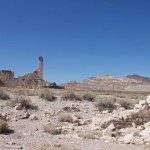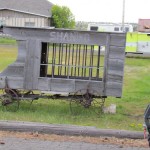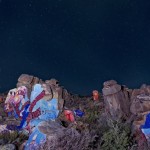TRUTH: Things that are haunted intrigue me, so abandoned ghost towns are right up there on my list of places I tend to explore. Despite being one of the largest states in the country, there are many parts of California that are more desolate than you can imagine; dried deserts and lake beds, mountain ranges stretching into the distance. Turn down a neglected road and you may not see another car pass by for miles. As I’ve discovered in my adventures over the years, these uninhabited parts of California are not only untouched, they’re abandoned.
California has long been a land of big dreams, however often times these dreams crumbled and turned to ruins, literally. There are hundreds of these broken dreams, scattered across all of California that would take months of pure devotion to visit but luckily, we’ve broken it down to 6 of the scariest ghost towns to check off on your bucket list.

Bodie | Mono County
Each year, many amateur and professional ghost hunters make their way to the historic ghost town of Bodie, California in hopes of catching a glimpse of the paranormal. The historic State Park is said to remain the home to several spiritual beings, despite the fact that no one actually lives here and the town is completely abandoned.
In the year of 1859, the popular W.S. Bodey paid a visit to this area and discovered gold. News spread quickly, and people flocked to the area for their chance of getting rich. Eventually the town of “Bodey” was formed. Since, the name has changed to “Bodie”. The once small town of several hundred people exploded to approximately 12,000 by the year of 1877. The city also grew with nearly eight hundred separate buildings. With greed, passion and overall lust running rampant in this upcoming town, the crime rate surged and it was not unusual for a fight to break out, or even a murder to take place.
Now, Bodie has an extensive history of hauntings and paranormal sightings that spook even the most seasoned ghost hunters. The most popular story is that of a man named Jim Cain, whose home is said to be highly paranormal. Mr. Cain hired a servant to care for his home, until rumors began to surface that she was his mistress. The disgraced woman was never able to find work after and took her own life. It is said her spirit still frequents the home of Mr. Cain.
It is also rumored that Bodie was cursed by a community of spirits to protect what is left of the town. If someone attempts to remove anything from the town, they are supposedly doomed to misfortune until they return that which they have taken. It is not unusual for the park officials to receive mail which returns even the smallest items people have stolen from the town. Some even include lengthy apology letters to both the physical and spiritual beings that reside in this ghost town.

Calico | San Bernardino
Three miles off a desolate stretch of Interstate-15, midway between Barstow and Yermo, lies the historic and restored ghost town of Calico, California.
In 1875, roving prospectors came across silver on the south slope of the Calico Mountains. However, it wasn’t until more than five years later that additional discoveries worth $400 to $500 per ton brought about a small rush. In the spring of 1881, came the discovery of the Silver King, Calico’s richest mine, and less than a year later the new settlement supported several businesses on a commercial street. But Calico’s demise was just as quick as its rise. When the price of silver dropped from $1.31 an ounce to 53 cents during the mid 1890’s, Calico became a ghost town. The narrow-gauge Calico railroad was dismantled just after the turn of the century and the town was officially kaput in 1907 with the end of borax mining in the district.
Calico isn’t all silver and riches. The old town is said to be haunted by a number of lingering spirits. One of the most often sighted spirits is that of Lucy Bell King Lane, a woman who spent close to seventy years in Calico. Although Lucy died close to five decades ago, she is evidentially still fond of her old home as she is frequently sighted there. When she is spotted, she is described as wearing a long black dress, most likely the lace she was buried in.
Others say they have seen phantom school teachers and another small child who has been known to grab people’s legs or pinch their ankles. Some visitors have also reported seeing a floating red light from inside the school.
Cold spots are also reported throughout the Calico mines, and feelings of “one’s hair standing up” in various places. Large orbs have also been photographed inside mines.

Panamint City | Inyo County
This large, well-preserved ghost town was also the scene of a natural disaster that killed many of the town’s residents. Founded in 1873 as a silver-mining town, its population soon grew to several thousand. The city had a mile-long main street, mills, stores, a red-light district, a post office, and even a cemetery at its peak. Panamint City was known as a “bad and wicked” town and because of its lawless reputation, Wells Fargo refused to open an office there. But in 1876, that all changed. A flash flood destroyed most of the town, killing many of the residents and turning Panamint City into a ghost town. A single dirt road to the city existed until 1983, when yet another flash flood washed the canyon down to the bedrock and made road replacement impossible. With no road out, the city was completely abandoned.
What’s left of the city includes:
- Native American pictographs predating the arrival of the miners
- Ruins of the original 19 th century stone cabins
- Newer cabins that have been maintained by backpackers
- A number of abandoned vehicles.
Today, Panamint City is still accessible but only by strenuous backpacking, and only a handful of people reach the city each year. The 5-mile hike is a tough one with over 4,000 feet of elevation gain and rock scrambling. The hike begins at Chris Wicht’s Camp, which is located six miles northeast of the ghost town of Ballarat.
The shells of houses and business that were occupied 139 years ago are haunting. A few wooden structures on the ledge above the original town site date back to the 1920s and 1930s, while the cabin which has been dubbed the “Panamint Hilton,” only dates back to the 1970s. Other equipment and structures are from as recent as the 1980s. Trek to Panamint City to explore the ruins and mines left behind, if you dare.

Vallecito | San Diego County
The name “Vallecito” means “Little Valley,” which dates back to when the Spaniards explored this vast land. The valley was a welcome relief to travelers after crossing the desert, which was known as the “Journey of Death.” Originally a stage stop between the Colorado River and San Diego, this town later became a stage stop on the Butterfield Overland Stage route. The town was built in 1852 and in 1934 the station was reconstructed to give visitors an idea of what the town was like in the pioneer days .
Like many places in the Old West, the station was witness to a number of violent crimes: including robberies and murders. It is from this darker side, that the station allegedly became haunted by the spirits of those who had met their death there.
One of the most famous ghost tales is the specter of the White Horse of Vallecito that allegedly began with a stage robbery long ago. When the stage was traveling on its way to Vallecito Station, four men on horseback held it up just before it reached Carrizo Wash. With guns pointed at the stage, the driver gave up a box containing $65,000 and the bandits took off immediately.
However, as they fled the scene, the stage driver fired a single shot, hitting one of the bandits. Once the rest of the robbers were gone he carefully approached the man he had shot and was to his surprise, found two dead bandits. It is believed the gang leader had killed one of his own men in order to keep a greater percentage of the loot . The two remaining bandits rode towards Vallecito Station, stopping somewhere between to bury their loot. When they arrived at the stage station, they got into an argument, both men shooting each other. The scared white horse ran through the door and out into the nearby hills.
Today it is said that the ghost of the White Horse continues to roam the hills near where the bandits buried their loot. It is said to appear around midnight before galloping through the sand and disappearing again. In the Carrizo Wash area there is supposedly a phantom stagecoach that has been seen numerous times over the past century.
Vallecito Stage Station is open for viewing Labor day weekend through the last week in May. It is closed during summer months.

White Mountain City | Inyo County
White Mountain City may have only been populated for a short amount of time, yet there are plenty of rock foundations of homes, corrals, and rock wall to leave behind its memory. White Mountain City was founded in the early 1860’s and a district formed in a deep bowl far from civilization. The area is most notorious for a scandal that occurred in which a successful candidate in the gubernatorial runoff of the state of California “padded” the elections by grossly exaggerating the number of people who voted for him from White Mountain City . He thought since White Mountain City was so remote, no one would check in on the votes. It was later found he used a list of passengers from a steamship for the basis of White Mountain City voters.
White Mountain City, however, wasn’t as booming as some other California ghost towns once were. Only a handful of settlers of the Deep Springs Valley area were found to be living there, and these settlers were primarily occupied in defending themselves from Indian attacks aside from seeking out a meager living along the banks of Wyman Creek. Mining on a small scale continued throughout the 1870s, then continued occasionally thereafter. In 1911, a unique college was built nearby, which today continues the tradition of its founder in that only the most gifted academic students may attend.
The site of White Mountain City is on a dirt road east of CA-168, northwest of Deep Springs near the Nevada border. Today White Mountain City is nothing but ruins left behind. It is readily available for exploring, if you dare venture into this desolate stretch of ruins.

Mentryville | Los Angeles County
Mentryville was an oil drilling town in the Santa Susana Mountains in Los Angeles County, abandoned by almost all residents during the mid 1930s. By 1962, Mentryville had become a ghost town, with only a caretaker family living in Charles Alexander Mentry’s old 13-room house left behind.
Pico Number 4, a short distance up the canyon from Mentryville was the first commercially successful oil strike in California and the longest running on record, before being capped in 1990. The Pico Canyon oil field proved to be the richest in the state’s history at that time and Mentryville became a boomtown from 1878 to 1900. At its height, Mentryville had 74 oil wells and produced 100,000 barrels of oil a year.
The town was named after the superintendent who was in charge of the oil field, Mentry. Mentry lived in the town until his death in 1900 and built the huge 13-room mansion that still stands there today.
This town was purer than other ghost towns, in fact the town lacked a bar. Mentry had reportedly “imbued the town with his puritanism as well as his name,” banning drinking and the use of foul language. Mentryville was eventually abandoned, partially because the amount of oil slowed over time and partially because of changes to the oil industry.
In 1995, Chevron donated the Mentryville site and the surrounding 800 acres in Pico Canyon to the Santa Monica Mountains Conservancy. A group called the Friends of Mentryville was organized to restore the buildings and open the ghost town to docent-led tours. The site is now registered as California Historical Landmark #516-2 .
Mentryville still has a creep factor, despite being preserved. In fact, the television series “The X-Files” and “Murder, She Wrote” have been filmed here. Some claim to have seen pentagrams and a bloody towel in one of the abandoned house. Others dispute these claims. The only way to know for sure is to take a trip to Mentryville yourself.

Photo Credit: Ian Burt , Nick , Randy Heinitz , Wikipedia , The Greater Southwestern Exploration , Kevin Stanchfield





 10 Arizona Ghost Towns to Check Off Your Bucket List
10 Arizona Ghost Towns to Check Off Your Bucket List